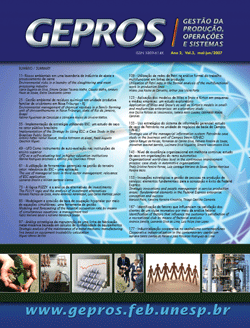Utilization of Petri nets in the formal analysis of the multifunctional work in production lines
DOI:
https://doi.org/10.15675/gepros.v0i2.158Abstract
The multifunctional workforce is a recurrent element in companies under dynamic production environments. The need for adequacy to the production flexibility demands the presence of multi-skilled workers, capable of performing a greater variety of operations. Specific research deeply focused on the effects of multifunctional work in the context of production systems by means of quantitative methods does not exist or lacks precision. On the other hand, the modeling of multifunctional behavior by means of simulation and modeling techniques is quite complex, thus motivating new approaches. The efficacy of Petri nets in production lines modeling is largely proved by recent bibliography, due to their simultaneous capacity of graphic visualization as well as formal analysis. The aim of this paper is the application of Petri nets formalism to the analysis of production lines with multifunctional work. Firstly, a workstation model was built and xx analyzed. Consecutively, the production flow was studied among different workstations. By means of Petri nets formalism, a mathematical equation was derived for the intermediary minimum buffer size (κ) calculation. The resultant κ has a crucial effect on the better use of available resources, such as the multifunctional workforce, in order to achieve higher levels of productivity. Keywords: Multifunctional work; Modeling; Petri nets.Downloads
Published
How to Cite
Issue
Section
License
O(s) autor(es) do artigo autorizam a publicação do texto na revista e garantem que a contribuição é original e inédita, não estando em processo de avaliação em outra(s) revista(s). As opiniões, ideias e conceitos emitidos nos textos são de inteira responsabilidade do(s) autor(es), não sendo a revista responsável por tais conteúdos.
Os editores da revista reservam o direito de efetuar ajustes textuais e de adequação às normas da publicação, caso necessário.
Os autores mantêm os direitos autorais sobre o trabalho e concedem à revista o direito de primeira publicação, sendo o trabalho simultaneamente licenciado sob a Attribution 4.0 International (CC BY 4.0), o que permite o compartilhamento do trabalho com reconhecimento da autoria e publicação inicial nesta revista.
Os autores têm autorização para firmar contratos adicionais, separadamente, para distribuição não-exclusiva da versão do trabalho publicada nesta revista (ex.: publicar em repositório institucional ou como capítulo de livro), com reconhecimento de autoria e publicação inicial nesta revista.












